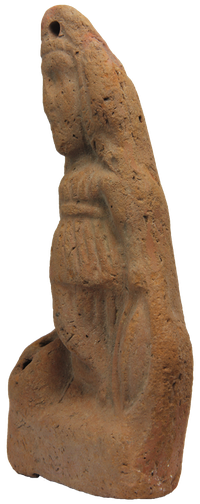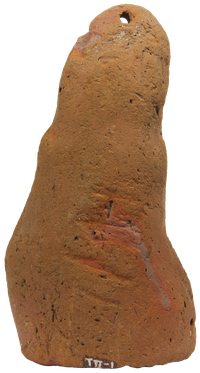Roman oil lamp from Egypt - Athena
Description: A female figure stands on a rectangular plinth, her left leg crossed with her right. She wears a girded sleeveless garment that reaches down to her feet and whose overlap ends below the hip region. Her left hand rests on a pointed oval shield with a sculpted rim and a central ridge, the right on an elongated rounded object with two openings, a lamp, which narrows upwards into a kind of handle.
The oversized head, which leans a little and turns to the right, is covered by a cap with the tip falling forward and flaps on the sides; it is pierced on the left side of the tip. The hair gives the face an almost rectangular frame, bordering the forehead horizontally with short broad strands, falling in narrow incised bundles beside the cheeks and spreading to the left and right on the shoulders. The face is cubic in shape in the upper section, then gradually tapers in the area of the smooth cheeks and ends in a slightly protruding chin. The eyes are wide apart.
Commentary: A close parallel, only a few millimetres smaller than the Giessen example and presumably dependent on the same matrix, is kept in the Akademisches Kunstmuseum in Bonn[2].
The left leg emerges as if naked from the translucent lower part of the garment, probably a peplos[3], fringed by a thick bead. The overlay is set off with vertical folds. The two attributes, the shield as a sign of the goddess Athena and the lamp with two openings connect the figure with the Egyptian goddess of war Neith, who was worshipped in Sais with festivals of lights[4]. Usually the goddess wears an aegis, usually also a Corinthian helmet, which is sometimes adorned with an Egyptian feather crown[5]. The headgear of the figurines Giessen/Bonn, on the other hand, resembles the Phrygian cap[6]. This could be "a simplification of the helmet"[7]. Numerous Athena figures are in fact depicted with helmets in various stages of stylisation, up to a kind of hood with the tip falling forward[8]. Drill holes next to the folded-over cap tips show that the figurines Giessen/Bonn were prepared for hanging.
Both the stance motif and the headgear can be compared to dainty Athena figures standing on supporting lamps. In this group, the shield appears on the right side of the goddess, who rests her left hand at her side[9]. In contrast to the somewhat larger-format statuettes, these 'carrying-lamp Athenas' appear to wear a short robe whose longitudinal folds reach mid-thigh, while the over-girdled apoptygma (overlap) ends at hip level. Signs of fabric panels next to the legs, which denote a long robe as in the Giessen/Bonn figurines, are missing. However, fine plastic elevations[10] can be seen on the crossing left ankle, which can hardly represent anything other than folds of fabric, the only indication of a long robe, the lower part of which is imagined to be transparent, made of thin fabric. The pleated section reaching to the thigh presumably corresponds to a far lowered colpos, the shorter one to the belted overlay. Athena is therefore also dressed here in her traditional, albeit alienated, peplos. In the Giessen/Bonn figurines, the pronounced frontality of Athena is softened by a spacey, downward movement of the crossing right leg[11].
The unusual size of the head in relation to the body, about 1:3, contrasts with the usual proportions of adult persons, namely head to body as 1:7. Approximately comparable proportions are found at most in individual Athena busts with miniature lamps[12], otherwise in childlike figures such as Harpocrates, demonic beings or grotesques[13].
Female hair costumes combining short, horizontally cut forehead fringes with long curls 'flowing' onto the shoulders are rarely encountered in this form. On a light house decorated with the relief of Athena[14] the shoulder curls are combined with short strands, but the latter form an arch over the forehead. Isis lactans on a 4th century wall painting from the oasis of Fayum shows similarities in the hairstyle, and the size and shape of the eyes, as well as the brows set almost at right angles to the root of the nose, also recall the physiognomy of the Athena figurine[15], but comparison with a work from a completely different art genre is always somewhat problematic.
For the Bonn parallel of the Giessen example, the 3rd/4th century AD had been suggested as the date of origin without further justification[16]. The few stylistic details include the large, deep-set eyes and the long, flat face, which merges abruptly into the lateral cheek area. The prominent chin is followed by a double chin. These features, together with the fancy hairstyle marked by incisions, can be taken as an indication that it originated in the later Roman imperial period[17]. Some busts of Athena associated with miniature lamps are the most suitable for comparison[18], even if they do not match the statuettes in all details in terms of motif and style.
Determination: Late antique, from Roman Egypt.
 |
 |
|---|
[1] Platon, Timaios 21e; Herodot II 28, 2. 59, 3. 170, 1; 175, 1; Pausanias II 36, 8; St. Pfeifer in: Ägypten Griechenland Rom, 599 f. nos. 173. 174; A. Geissen – M. Weber, Untersuchungen zu den ägyptischen Nomenprägungen VI, ZPE 155, 2006, 274.
[2] H: 16,9 cm, inv.-no. D 54. „Die eigenwillig gestaltete Figur hat keine direkte Parallele“, St. Schmidt ibid. 79 f. Slight differences in the folds at the top of the garment and in the posture of the crossing leg could have occurred during the subsequent processing of the object after it was removed from the mould before kilning.
[3] In contrast, "Chiton" with "Kolpos", St. Schmidt ibid. 79 f. cat. no. 80 pl. 29.
[4] Herodot II 28; 59; 170; Platon, Timaios 21e; F. Perpillou-Thomas, Fêtes d’Égypte ptolémaïque et romaine d’après la documentation papyrologique grecque (Winksele-Herent 1993), 121 f. note 237-239.
[5] Ewigleben ibid. 32.
[6] Vgl. Fischer ibid. 1994, nos. 948. 949 pl. 100.
[7] St. Schmidt ibid. 79 f.
[8] Cf. Bayer-Niemeier ibid. 181 pl. 68, 2-4; Ewigleben ibid. 76 figs. 73. 74; LIMC II ibid. 1046 no. 36 pl. 767.
[9] The goddess leans against a column whose capital, a so-called cheniscus, i.e. the head and neck of a goose, serves as a handle. Ewigleben ibid. 37 no. 74 pl. 76; with helmet: Fischer 1994, 434 no. 1190 pl. 126; Schürmann ibid. 276 f. no. 1048 pl. 174; with Dionysus instead of Athena ebenda, 278 no. 1053 pl. 175.
[10] Schürmann ibid. 276 f. no. 1048 pl. 174.
[11] On the softening of the frontality and more relaxed posture of the late period, e.g. by "advancing a knee or shoulder", with reservation, as this is a completely different landscape: V. von Gonzenbach, Die römischen Terrakotten in der Schweiz Band A (Tübingen und Basel 1995) 365.
[12] E. Breccia, Terrecotte figurate greche e greco-egizie del Museo di Alessandria (Bergamo 1934) 30 f. no. 227 pl. 46.
[13] Ewigleben ibid. 43 fig. 9; 45 fig. 11; id. ibid 64 fig. 50. 51; cf. also the Bes figures next to Athena in a long peplos, Schürmann ibid. 276 pl. 174; Fischer 1994, 200 nos. 359. 360. 367 pl. 32; 202 no. 366 pl. 33.
[14] Fischer 1994, 431 no. 1180 pl. 124.
[15] Heroen, Götter, Scharlatane (Mainz 2008) 84 f. fig. 44; plus the musicians and gift-bearers of a tomb painting in Silistra/Moesia, 2nd half of the 4th century., R. Bianchi Bandinelli, Rom. Das Ende der Antike (München 1971) 325 f. fig. 306.
[16] St. Schmidt ibid. 80.
[17] F. W. Hamdorf, Die figürlichen Terrakotten der Staatlichen Antikensammlungen München (München 2014) p. 674 F 89. H. Cassimatis, who addresses the problem of an exact dating for the terracotta statuettes and figurative lamps from Alexandria and the Fayum, places the pieces in her catalogue predominantly in the late Roman Imperial period: „Dans la majorité des cas il s’agit de l’époque romaine, impériale et souvent tardive“, id. ibid. 1048.
[18] Schürmann ibid. 275 f. no. 1045 pl. 174; Fischer ibid. 1994, 948. 949 pl. 100.

